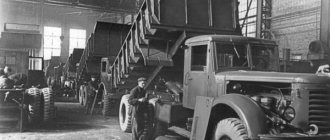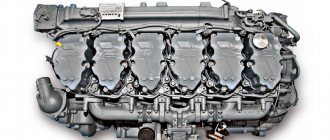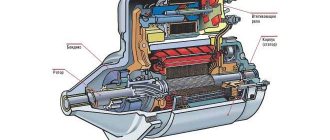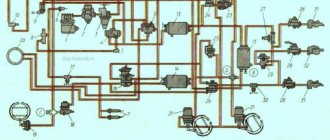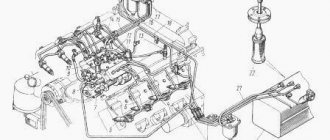Malfunctions of high-pressure fuel pumps on a diesel engine lead to a loss of power, an increase in fuel consumption, difficult starting, an increase in exhaust smoke, and others. Typical breakdowns of the high-pressure fuel pump of a diesel car include water ingress into the plunger pairs, a drop in pressure in the plunger pair, a violation of the integrity of the sealing rings, a sensor or wiring malfunction (in electronically controlled diesel engines). Ideally, it is necessary to check the high-pressure fuel pump at a special stand in a car service, however, the simplest checks of the fuel pump can also be done in the garage.
Fuel pump types
To begin with, we will deal with the types of fuel pumps for diesel cars, since each of them has its own characteristics and typical malfunctions of the high-pressure fuel pump. So, knowing what type the pump belongs to, you can better understand the principle of operation and the direct cause of the breakdown. Regardless of the type of high-pressure pump, it must be understood that the main unit is the so-called plunger pair - a piston (plunger) and a cylinder (sleeve).
In total, there are two main types of injection pumps:
- with direct action and mechanical action of the plunger;
- with battery injection.
However, high pressure fuel pumps are still divided into classes according to their design. In particular:
- Inline . As the name implies, they have working sections arranged in one row, and fuel is supplied to each cylinder in turn.
- Distribution . For such pumps, one section of them can supply fuel to several different cylinders. Such devices can be one- and two-plunger.
- Multisectional . Their other name is V-shaped or hydraulic accumulators. They are used for high power, but low speed engines. They are quite rare.
In fuel pumps with direct injection, injection and injection occur simultaneously. The mechanical drive of the plunger is responsible for this. For accumulator pumps, fuel is supplied in separate cycles, first it enters the pump accumulator, and only then it enters the nozzles. The most modern systems are electronically controlled and are called Common Rail. They work on the basis of information from numerous sensors located in different parts of the car.
Another injection system is a pump-injector. In this case, they are combined into one mechanism. Such a system simplifies pressure control, and also increases reliability, because if one nozzle fails, the motor will continue to work, albeit with less power.
High-pressure fuel pumps have also been invented for gasoline engines. They are used in engines with direct fuel injection. The task of the pump is to supply gasoline at high pressure to the cylinders, where the fuel is directly mixed with the air mass, forming a mixture that is ignited by a spark plug.
Principle of operation
From the tank, through a coarse filter, with the help of a low-pressure fuel pump, the fuel, through the fuel line, first enters the fine filter, and then to the inlet to the injection pump. From the crankshaft of the engine, torque is transmitted to the fuel pump, or rather to the camshaft, which in turn drives the pushers. Pushers put pressure on springs that lift the plunger. The plunger closes the intake valve, fuel is supplied to the nozzles, which spray it already in the cylinders. The cam shaft, turning further, lowers the plunger, thereby opening the flow of fuel into the injection pump and the process repeats.
It seems to be nothing complicated, however, it is not quite so. Any injection pump is a very complex mechanism, which is based on plunger pairs. They are made with very high precision. One such pair consists of a cylinder and a piston, which move and create high pressure in the system.
Symptoms of a malfunction of the injection pump
Despite the fact that high-pressure pumps belong to different types, the signs of their partial failure are typical and in many ways common to all. So, the symptoms of a malfunctioning fuel pump include:
- increased fuel consumption in all engine operating modes;
- unstable operation of the engine, especially at its low speed;
- difficulty starting the engine, more often in the cold season;
- drop in engine power and dynamic characteristics of the machine as a whole;
- increase in engine exhaust smoke;
- fuel leakage from the high pressure pump;
- the appearance of an oil emulsion in the engine coolant;
- increased engine noise.
Please note that the symptoms listed above may be signs of a breakdown in other parts of the car's engine, such as the cooling system. Therefore, the condition of the high pressure pump must be diagnosed separately.
Experienced motorists highlight another sign of a malfunctioning high-pressure pump plunger. It consists in the fact that “hot” the engine may stall when idling. And at the same time, it will be almost impossible to start it until the pump itself cools down. "On a cold" engine starts without problems.
How to remove the injection pump
- disconnect the cables for manual control of the engine stop lever and the governor control lever,
- remove the fuel control rod,
- disconnect all pipelines for supplying fuel to the pump, outlet and drainage pipelines and the pipeline from the fuel fine filter,
- disconnect the pipe for supplying oil to the pump and the oil outlet pipe,
- unscrew the coupling bolt of the front flange of the drive half-coupling and two bolts of the driven half-coupling (in order to unscrew the bolts it was convenient to turn the crankshaft through the hatch of the clutch housing),
- disconnect the flare plug fuel lines,
- remove the high pressure fuel lines,
- disconnect the tube that supplies air to the auxiliary brake working cylinder,
- unscrew the four bolts that secure the injection pump,
- remove the pump itself.
The main causes of a malfunction of the injection pump
The following causes of failure of the high pressure pump are distinguished. Usually they fail the following structural elements:
- Plungers . Most often they are to blame, since plunger pairs quickly become contaminated. This is due to two reasons. The first is design features that provide for a small gap that provides high pressure in the system. The second is the low quality of diesel fuel, in particular, the presence of sulfur and paraffins in it, which, in fact, pollute the device. Also, dirt can get from the engine (soot, dirt). The wear of the plungers leads to unstable operation of the engine at idle, increased fuel consumption, and a decrease in compression. Due to damage to the plunger pair, the bearings can overheat significantly.
- Water in diesel fuel . Also, often in domestic diesel fuel there is an increased water content. Moisture washes away the fuel (simultaneously protective) film from the surfaces of high-pressure fuel pump parts, due to which the resource of precision parts is significantly reduced. It may even cause the pump to seize.
- Dirty fuel filter . Due to a clogged fuel filter, the high-pressure pump, firstly, can become dirty (plunger pairs), and secondly, it runs “for wear”, which reduces its overall life.
- Uneven supply and distribution of injected diesel fuel . Such a problem can also be caused by a malfunction of the plunger pairs, in particular, wear of the drivers, rack teeth, delivery valves, and dirty nozzles.
- Manufacturing marriage . This situation is quite rare, but sometimes it occurs on cheap pumps. Marriage includes cracks in the high-pressure fuel pump housing, damage to its bearings, as well as jamming of the plunger bushing.
- Bearing wear . They usually wear out due to a critical decrease in resource (aging). Alternatively, a factory marriage. All this leads to the fact that the performance of the pump deteriorates, and the bearings and adjacent parts overheat, which reduces their working life.
- Piston and bushing jamming . This is a critical failure that can lead to breakage of the gear rack, camshaft, gear, regulator, keys. Often the cause of jamming is the ingress of water into the cavity between the piston and the sleeve.
- Wear of pump parts . This can occur both for natural reasons (with an increase in the mileage of the car), and when water gets inside it. It washes out the protective (working) lubricant from the elements, which significantly reduces both the life of the pump as a whole and its individual parts.
- Plunger pair corrosion . Rust spots can appear due to the increased water content in diesel fuel.
- Incorrect operation of the cooling system . That is, with prolonged and / or heavy loads, the high-pressure pump may simply overheat. The cooling system may be faulty for various reasons - low levels of antifreeze or antifreeze, clogging of the system, breakdown of individual elements (pump, pipes, radiator, and so on).
- System depressurization . This can happen not only if the seals of the high pressure pump are damaged, but also other sealing elements. In any case, in case of depressurization, the high-pressure fuel pump will operate in an increased load mode, which will not only reduce its resource, but also lead to the described breakdowns.
- Incorrect operation of the injection advance valve . This unit is installed on modern common rail diesel systems in order to increase engine efficiency and reduce fuel consumption. Said advance valve is in turn controlled by a corresponding solenoid valve of the high pressure pump. The system is controlled by the ECU, which commands the plunger, which opens the valve mechanism. Thus, the pressure in the system is regulated.
- Plunger return spring failure . If the spring breaks in one place, then it will be a partial failure, and the section will work, but with low efficiency. If the spring breaks in several places, then most likely the section will completely fail. In some cases, there is a decrease in the pressure valve spring stiffness. In this case, it is desirable to replace it.
If there is a suspicion that the fuel pump rack or related parts are faulty, then you need to check the presence / absence of the following defects:
- disconnection of the rail from the parts of the regulator;
- jamming or loosening of the clamps of the plunger drivers;
- jamming of the coupling screws of the gear rims.
One of the most dangerous causes of a malfunction is a violation of the mobility of the fuel rail. In particular, if it jams at the moment of maximum fuel supply, and, accordingly, the regulator does not have enough effort to shift it to its original position, then an emergency increase in the number of revolutions of the crankshaft occurs in the engine, due to which the engine “runs out” with all ensuing consequences. If the rack is "bitten" when the gear is off, then in this case it will be impossible to start the engine at all. Partial jamming of the rail leads to unstable operation of the engine and an increase in its sound output (it begins to “growl”).
When using the machine in conditions of significant frost, freezing of individual parts of the pump is sometimes observed, and its partial failure. To prevent this, it is necessary to use oils and diesel fuel with appropriate temperature indicators.
In common rail diesel systems, the control valve (or SCV flow valve) may fail. Usually it is replaced with a new one. Less often, they perform an audit and change individual parts to new ones. In particular, the core valve stem is often replaced.
How to identify malfunctions of the injection pump
Please note that it is best to test the high pressure pump on professional stands specially designed for this. They allow you to find out the performance of the pump and other elements of the fuel system of the car. However, such a check is possible only in a car service, since such a stand is specialized and expensive equipment. In garage conditions, however, it is possible to carry out only a partial check of the high-pressure fuel pump and determine only the main malfunction, while other possible ones cannot be noticed!
Checking the presence of water in plunger pairs
To do this, remove the timing belt (timing) and carefully twist the pulley. If it rotates with variable force, then everything is fine, and there is no water in the pump. If the rotation occurs under the influence of significant effort and does not occur at all, then moisture has a place to be. This is very harmful for both the pump and the engine as a whole, since the motor will work with increased force at startup, up to its complete jamming (failure).
Checking the pressure in the plunger pair
For this, there are special tools - testers, for example, KI-4802 or TAD-01A. If there is no such tool at hand, then you can use a pressure gauge with a high measurement range. So, it must be screwed onto the seat of the fuel pipe, or into the central hole of the high pressure pump head. With a normal running engine, pressure readings should be approximately 300 kg / cm² and above (in fact, the corresponding value will vary for different brands of cars, as well as engine operating modes). If the fuel pressure is lower, it means that the plunger pair has worn out significantly and needs to be repaired or replaced (most often).
Control sensors
In modern diesel common rail systems that are controlled by an ECU (electronic control unit), as a rule, there are problems with the sensors and / or with their signal wiring. Often, this activates the Check Engine warning light on the dashboard. It is necessary to use the error scanner to read their numbers and decrypt them. Then, in accordance with the information received, make a decision on the repair.
Mostly sensors fail (due to damage or old age), or there are wiring problems. For example, wires are frayed at the place of vibration and kinks, break off, their insulation value decreases. All this leads to the ECU receiving incorrect information from them, which leads to the formation of incorrect control signals.
fuel leak
If diesel fuel flows precisely from the injection pump, then most likely the reason for this is the wear of its o-rings. For diagnostics, it is necessary to shake the axis of the pump lever with the engine running . If the o-ring is damaged, diesel fuel will ooze out from under it. Sometimes leakage occurs from the installation sites of plunger pairs. In this case, it is necessary to diagnose them. To do this, the high pressure pump is usually dismantled.
To check the tightness of the injection pump cut-off valve, do the following:
- unscrew the high pressure pipe from the faulty section;
- put the rail of the pressure pump in the off supply position;
- using a manual booster pump, artificially create excess pressure in the fuel system.
If the valve is faulty, then fuel will flow through the pressure fitting hole . Otherwise, the valve is OK.
Reiki grip
To check the rail for sticking, you must first disconnect the rods from the regulator lever, as well as the stop bracket. Next, using the pump control levers, you need to move the rail to its extreme position. Accordingly, during the movement of the rail, you can understand whether it has “been boiled” or not. It is advisable to also rotate the camshaft several times. Ideally, the rail should move smoothly and without jerks.
You can also see the movement of the rail with your own eyes, however, for this you need to perform certain dismantling work. Most motors require the pump cover to be removed. For YaMZ engines, you need to unscrew the limiter housing or plug.
pump freezing
In the event of a malfunction of the high-pressure fuel pump in the winter, you can check whether it is frozen. If the pump is frozen, it must be dismantled and brought into a warm room. Then wait until it warms up and the mobility of the rail is restored. Next, the pump must be disassembled, drained of oil and washed with clean diesel fuel. After that, it is necessary to pour new oil into the crankcase and install it back on the engine. And when this happens in especially severe frosts, they also use a defroster for diesel fuel to defrost the entire fuel line.
Stand use
In the conditions of a car service, the masters use special diagnostic stands, with the help of which they check the operation of the high-pressure pump. In particular, the first thing they pay attention to is the performance of the pump. Also check the operation of the plunger and control valve (SCV flow valve).
The system is connected to the shaft position sensor so that the controller “sees” the position in which the injection is taking place, as well as to the fuel portion control valve. Next, the stand is put into operation and a certain number of cycles (several hundred) are counted. As a result of the operation of the pump, a certain amount of fuel flows from the nozzles into pre-prepared beakers, according to which it is possible to judge the performance of both each of them and the fuel portion control valve.
In some cases, the masters change the control valve to a known good one in order to determine the real state of the plunger pair.
High pressure fuel pump repair
How to troubleshoot a high pressure fuel pump depends on the type of device, as well as the cause of the breakdown. We list the most common repair measures.
Replacing a plunger pair with your own hands
Before performing an independent check (without using a special stand), you must have locksmith tools and a new plunger pair on hand, as well as have experience in performing repair work. We will describe the description of checking the condition of the high-pressure fuel pump using the example of the common Bosch injection pump.
It must be understood that the dismantling of the pump depends on the specific model and even the engine of the car, so the procedure will be described in general terms. So, to replace a plunger pair (the most common type of repair), you must:
- remove the terminals from the car battery;
- disconnect from the high pressure pump all wires and hoses suitable for it;
- dismantle parts that prevent its dismantling from the machine;
- unscrew the fasteners and dismantle the pump;
- carefully disassemble the pump, while it is important not to lose small parts, and also remember the disassembly sequence (you can photograph this process in stages on your phone);
- unscrew and dismantle the plunger from the pump;
- clean all parts of the pump from dirt (you can use special carb cleaners or similar cleaners for this);
- check the rollers, bearings and rails on the pump, they should not have significant wear;
- dismantle the valve and the so-called “jammer” from the old plunger pair, and then install them on a new pair;
- carry out assembly work in reverse order.
Please note that the replacement of the plunger pair can only be performed if you are completely sure that this assembly is partially out of order, since it costs a lot of money.
Reiki sticking
If you find that the rake is sticking, then the first thing to do is to find the place of its “sticking”. This can be done by pumping up the ring gear relative to the rack in the corresponding section. If the rail does not stick, then there will be a small gap.
Self-repair in this case is hardly possible. However, in any case, it is necessary to dismantle the pump and show it to a specialist!
Preventive measures
As you know, prevention is the best repair, therefore, in order to save money and ensure the normal operation of the engine, it is advisable to perform simple preventive measures that help extend the life of the high pressure fuel pump. In particular:
- flushing the fuel system should be done approximately once or twice a year;
- be sure to change the fuel filter in time (it is undesirable to clean it, because small particles of dirt are likely to remain on the filter);
- use high-quality fuel (at any gas station there is documentation that indicates how long ago the fuel was brought, as well as information about its composition, tolerances and seasonality );
- in winter, it is important to use winter diesel fuel, or to lower the freezing point (increase the fluidity) of diesel fuel, you can use special compounds - antigels;
- it is advisable to leave the car for a long parking (especially in cold weather) with a full tank, because during the night moisture condensate forms on the inner walls of the tank, which flows down and mixes with the fuel, instead you can use the above-mentioned dehumidifiers;
- prevent a critical drop in the fuel level in the tank;
- in winter, it is imperative to warm up the engine for several minutes before driving, taking into account the readings of the coolant temperature and oil pressure instruments;
- use special lubricating additives for diesel fuel if there is a suspicion of low quality diesel fuel.
The measures listed above will contribute to the normal operation of not only the high pressure pump, but the entire vehicle fuel system as a whole.
Bosch high pressure fuel pump check valve for KAMAZ
KAMAZ EURO-2 stalls on the go
Check valve for injection pump BOSCH VE
Man tga. Repair. Check valve tnvd.
How to check the fuel check valve
Kamaz troit stalls
Checking a faulty and serviceable Bosch VP30 high-pressure fuel pump valve on the engine and on the stand
HPFP Bosch Kamaz Euro 2
injection pump drive KAMAZ Part 2.
Return valve for injection pump Euro 2 VG2600080213
alteration of the return valve of the high-pressure fuel pump Mitsubishi Pajero (Mitsubishi Pajero), with a 4m40 engine for KAMAZ
See also:
- Locker for KAMAZ 4308
- Body parameters of KAMAZ 53212
- Convert KAMAZ checkpoint to MAZ
- Hydraulic cylinder of the KAMAZ lift
- How to remove the speed limiter on KAMAZ
- KAMAZ in the mud is cool
- Odometer coiler KAMAZ
- How to reduce pads on KAMAZ video
- Wiring diagram KAMAZ 65117 with cummins engine
- Remove the boiler from KAMAZ
- KAMAZ undercarriage lubrication
- Stocking air filter KAMAZ
- Bearing 306 KAMAZ
- KAMAZ accident at the crossing
- Specification KAMAZ 55102
Home » Novelties » Bosch high pressure fuel pump check valve for KAMAZ
kamaz136.ru
